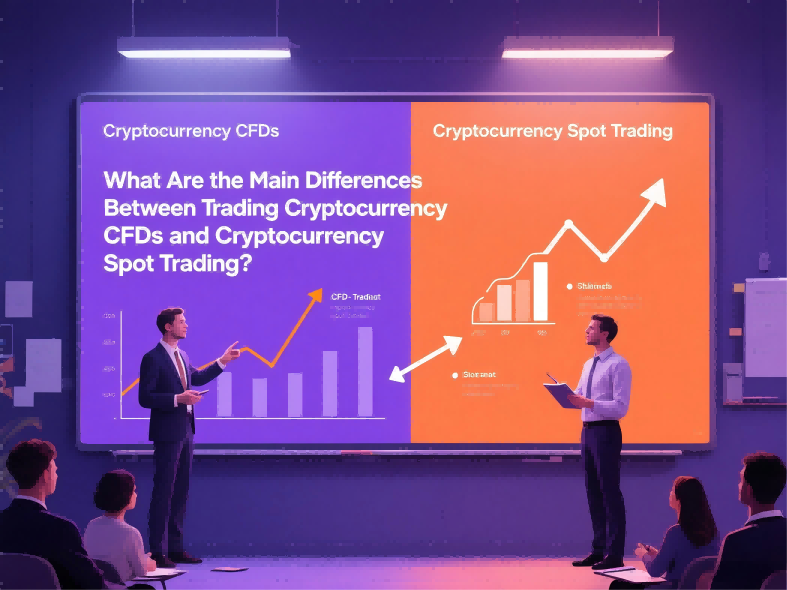Not all crypto trades are created equal — the way you trade matters just as much as what you trade.
If you’re exploring the world of cryptocurrency trading, you’ve probably come across two very different approaches: spot trading and CFD (Contract for Difference) trading. While both involve speculating on digital currencies like Bitcoin or Ethereum, they operate on completely different principles. Understanding the key differences can help you choose a trading style that fits your goals, risk tolerance, and market strategy.
Whether you're a long-term believer in crypto or just looking to take advantage of market swings, it’s important to know what you’re really signing up for when you pick a trading method.

The most obvious difference comes down to what you're actually buying. With spot trading, you’re purchasing real crypto. You own the asset, you can transfer it to a wallet, stake it, or hold it for years. Your profit depends entirely on the asset's value increasing.
With CFD trading, you're not buying the actual coin. Instead, you're trading a contract that mirrors the price movement of the underlying asset. This means you can speculate on both upward and downward price movements — without ever owning the crypto itself.
Spot traders hold. CFD traders move.
Let’s say Bitcoin is trading at $30,000. In the spot market, that’s how much you’d need to buy one BTC outright. With a CFD platform, you can access that same exposure using leverage — sometimes as high as 1:100 or even more — meaning a much smaller upfront investment can control a larger trade.
Of course, leverage can work both ways. It amplifies gains, but it also increases your exposure to loss. That’s why reputable CFD platforms include built-in tools like stop-loss orders and negative balance protection.
If you're looking for short-term trades without tying up a lot of capital, CFDs offer flexibility that spot trading just doesn’t.
In the spot market, your only real option is to buy low and sell high. If the market’s crashing, there’s not much you can do except wait it out.
CFD trading changes the game by allowing short positions. You can trade market downturns and profit from falling prices just as easily as rising ones. This is why many active or professional traders prefer CFDs — you don’t have to wait for a bull run to make a move.
“CFDs let you trade the trend — no matter which direction it’s going.”
Spot trading usually requires setting up a wallet, managing keys, and occasionally dealing with blockchain congestion or transfer fees. It’s part of the crypto experience, but it adds layers of complexity.
CFD platforms simplify the process. No wallets, no chains, no network fees. You focus purely on trading price movements. Most platforms also offer commission-free trades with tight spreads, so it’s clear what you're paying — and when.
Spot exchanges often prioritize storage and transfers over deep technical analysis. CFD platforms are built with traders in mind. That means powerful charting tools, real-time analytics, custom alerts, and even copy trading options if you're still learning the ropes.
If you’re the kind of person who trades with a plan — based on patterns, news, or price action — CFD platforms tend to offer more of the features you’ll actually use day to day.
If you're into holding crypto for the long haul, believe in decentralization, or plan to use your crypto for other blockchain-based services, then spot trading is probably your best bet.
If you’re looking for more flexibility, faster trades, or the ability to react to both rising and falling markets — and you’re not interested in managing crypto storage — CFD trading might be more your speed.
“You don’t have to own crypto to trade it like a pro.”
Trading crypto isn’t one-size-fits-all. It’s about knowing how you want to engage with the market. Spot trading and CFD trading each offer unique advantages, but they serve very different purposes. Choose the one that matches your strategy — not just your curiosity.
And remember, no matter how or what you trade, your platform should make things easier, not more confusing. The right tools, the right support, and the right structure can turn market volatility into your edge.
Spot trading is straightforward: you buy an asset like Bitcoin, Tesla stock, or gold, and you profit if the price goes up
Read MoreTrading has always carried an air of possibility. The idea of turning a well-timed decision into a life-changing profit a
Read MoreStart your CFD trading
Your All in One Trading APP PFD